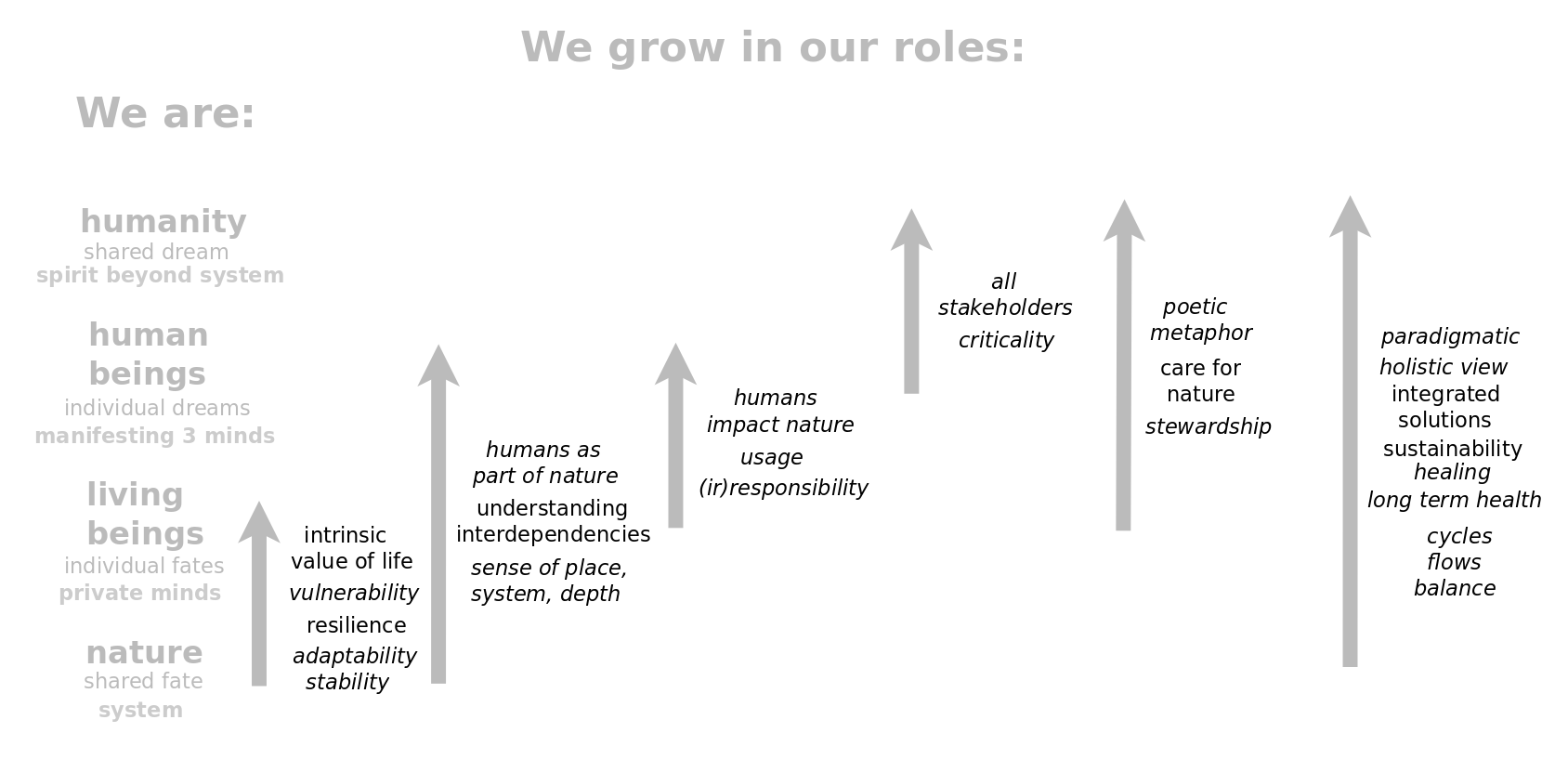Andrius Kulikauskas leads this investigation:
What is ecological thinking?
Andrius: We are working on this at these venues:
- Lovers of Wisdom discussion group starting in July, 2024. Here are selections from our discussion.
Overview of concepts
2024.07.31 Andrius: I have organized the ecological concepts we identified. I see four roles that humans identify with. We are nature (our shared fate), living beings (our individual fates), human beings (our individual dreams) and humanity (our shared dream). As living beings, we manifest our being, as human beings, we manifest our doing (our ecological practice), as humanity, we manifest our thinking (our ecological thinking), which is to say, our culture.
This resonates strongly with our vision for Econet as relating ecological practice with ecological thinking. Our three themes directly address three of the levels in the diagram.
- Living beings: We respect agency in all that surrounds us.
- Human beings: We promote human dignity by meeting the basic needs of humanity.
- Humanity: We expand on science by exploring our subjective worlds.
In this diagram of ecological thinking, the 4 levels are 4 ways of thinking of a person. They are part of nature (shared fate), and beyond that, they are a living being (with an individual fate), and beyond that they are a human being (with their own inner conflicts and dreams), and beyond that they are part of humanity (a shared dream that is the harmony of all of our dreams).
The 6 pairs of levels (as indicated by the 6 arrows) are the 6 concepts that came up in our thoughts on ecological thinking. Morally, they have us not reduce people (or perhaps life in general) from a higher level to a lower level.
- not reduce a living being to nature - for life has intrinsic value, is vulnerable yet resilient, adaptable yet stable
- not reduce a human being to nature - for humans are both independent and interdependent, they have a personal sense of place, system, depth
- not reduce a human being to a living being - for human beings have dreams, and in realizing them, they impact nature, utilize resources, can be responsible or irresponsible, which means honoring their sovereignty
- not reduce humanity to human beings - for humanity is more than the sum of its parts, and need integrate all of the stakeholders, the roles humans play, the various aspects in which they care for nature
- not reduce humanity to living beings - for living beings, rather, are poetic cultural metaphors by which together we care for nature as stewards
- not reduce humanity to nature - for nature is a paradigm of integrated solutions, cycles, flows, balances, for appreciating sustainability, healing, long term health, having a holistic view, and yet it is humanity that consciously applies this paradigm, learns from nature, but not nature itself
By not reducing levels, all 4 levels function in parallel and allow for support of the higher levels. This means that humanity can flourish as a culmination of nature, a spiritualization of nature.
This model is anthropocentric in that it is based on studying how we, humans, think and act and live. It clarifies the human role. This model shows the importance of fragmentation. The moon, the sun, the planets and empty space are all natural. What has happened on earth is, first of all, the fragmentation of nature into living beings. The distinction of human beings is that furthermore we have inner conflict, we can have aspirations and consciously pursue them, and reveal our inner conflicts to each other. Which is to say, a dolphin or an ant colony would be a fine human being if we could have an inkling of their inner conflicts. A person with no inner conflict is a failure. A person like Jesus, who has reason to say to God - "Not my will but your own" or "Why have you abandoned me?" is a success. This suggests that humanity also needs inner conflicts by which it grows. By this inner conflict we and our dreams can come together. This is one model. What are other models? How are the models related? Which of the models are valid or not and why? I appreciate our further thinking
2024.08.20
Andrius: More to consider, thanks to Marcus, are the 8 principles of Elinor Ostrom for governing the commons (which I took from here:
- Clearly defined boundaries.
- Regulations made by the commoners that correspond to the needs and conditions of the community and their environment.
- An established system for decision-making that allows individuals affected by the regulations to change the regulations.
- Monitors drawn from, or accountable to the community of commoners who actively ensure the rules established by the commoners are being adhered to.
- Graduated sanctions for members who violate regulations. These are determined by members of the community, or by individuals accountable to the community.
- Conflict-resolution mechanisms that are low cost and easily accessible for members of the commons.
- The ability to create regulations without the infringement of an outside authority.
- Decentralized decision-making in the case of larger commons.
Previously
2024.07.18 Andrius: I made the diagram above. I took the concepts in regular font from the answer Leland received from ChatGPT. I drew the concepts in italic font from letters at the Lovers of Wisdom forum. My own concepts are in gray.

